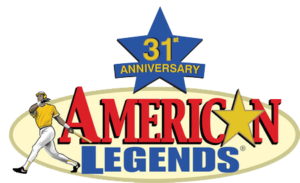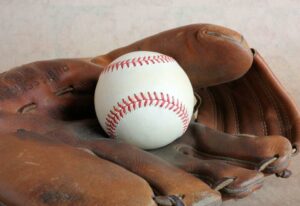Willie Mays Baseball Cards
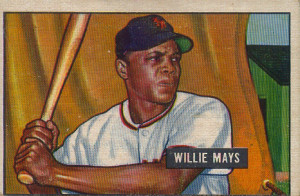
Mays had only one hit in his first 26 At Bats for the New York Giants (a homer off of the Braves’ Warren Spahn) and presumed that his Major League career would quickly become a Minor League career.
Not so, said his manager Leo Durocher “As long as I’m the manager of the Giants, you are my center fielder.” When Mays joined the Giants in May of 1951, the ball club was in fifth place. Four months later, they had tied the Dodgers for the league lead, forcing a three-game playoff.
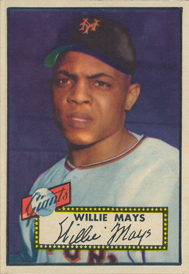
Mays played in all six World Series games in the Giants’ 4 games to 2 loss to the Yankees. Mickey Mantle, the player Mays would perpetually linked to, was also playing in his first Fall Classic.
The linkage continued to the baseball card arena as Mays and Mantle were the focal points of the 1951 Bowman Baseball Card set. While not as expensive as Mantle, the 1951 Mays rookie card #305, is the second most valuable in the set.
The following year, both players would make their Topps debuts as Mantle’s card became THE iconic card of the set. Still, the 1952 Topps rookie card #261 of Mays is one of the company’s most coveted and expensive cards ever produced.
After being drafted (this time by the U.S. Army who outranked the Giants), Mays missed the majority of the 1952 season and the entirety of the 1953 season.
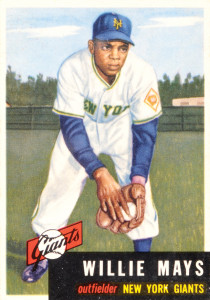
Undoubtedly, Mays’ inclusion in the 1953 Topps series was attributable to the special relationship that he shared with Sy Berger of Topps.
In 1954, Mays was out of the Army and back with the Giants and National League pitchers paid the price. Mays blasted 41 homers while leading the league in batting with a stellar .345 average. He also captured the National League Most Valuable Player Award en route to the Giants first World Series Championship in 21 years.
The Giants 97-57 record was fine by N.L. standards, but their World Series matchup was against the 111-43 Cleveland Indians. In the eighth inning of Game 1, with the scored tied at 2 and two Indians on base, Willie Mays changed the course of the Series.
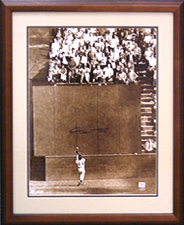
The Giants would go on to win the game in the bottom of the tenth inning and complete an improbable four game sweep of the heavily favored Indians.
Mays became the shinning star of the National League as the card releases of 1954 demonstrated. Willie was featured in the 1954 sets of Bowman, Topps, Red Man Tobacco, Stahl-Meyer Franks and the New York Journal-American.
This was also the year of Mays’ All-Star Game debut. He would be a fixture at the Midsummer Classic from 1954 through 1973.
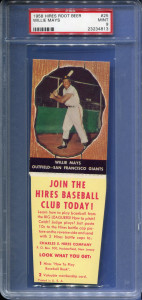
Mays’ legend would continue to grow in 1955 when he walloped 51 home runs and finished second in the National League in Stolen Bases.
It was becoming apparent that Mays was not just a 5-tool talent (hit, hit for power, field, throw and run), but a generational player who would go on to be one of the game’s greatest.
At one time or another, Mays would lead the league in virtually every offensive category; Batting Average (1954), On Base Percentage (1965 & 1971), Slugging Percentage (1954, 1955, 1957, 1964 & 1965), Runs Scored (1958 & 1961), Hits (1960), Total Bases (1955, 1962 & 1965), Triples (1954, 1955 & 1957), Home Runs (1955, 1962, 1964 & 1965), Base on Balls (1971) and Stolen Bases (1956-1959).
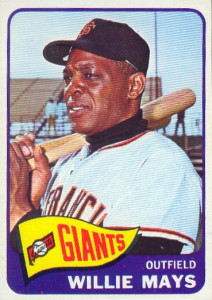
Willie retired in 1973 after a season and a half with the New York Mets. His last regular issue trading card is the 1973 Topps #305 (one of my personal favorites), but his last playing era card is actually in 1974. Although uncredited on the card, the 1974 Topps #473 ’73 World Series Game #2 pictures Mays taking a cut against the A’s.
During his career, when it came to making Willie Mays baseball cards, the manufacturers followed The Kinks mantra of “give the people what they want.” Between 1951 and 1973, Mays was featured on almost 250 different trading cards, trailing only Mickey Mantle during the era.
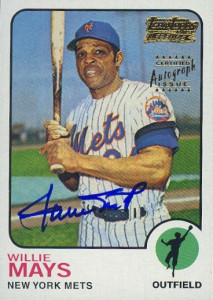
Besides his annual appearance on Topps All-Star and League Leader cards, he was an almost annual subject on combo cards; 1958 Topps Rival Fence Busters (with Duke Snider), 1959 N.L. Hitting Kings (with Richie Ashburn), 1960 Master and Mentor (with Bill Rigney), 1962 Manager’s Dream (with Mantle), 1964 Giant Gunners (with Orlando Cepeda), 1967 Topps Fence Busters (with Willie McCovey) and the 1968 Super Stars (with Mantle & Harmon Killebrew).
When all is said and done, very few players can be mentioned with Mays. He was a unique blend of ability, desire and charisma. His final numbers of 660 HRs, 1903 RBIs .302 BA are phenomenal (and untainted by PEDs). It’s no wonder that Mays is a member of Baseball’s All-Time Team and still one of the most collected players of the 20th century.
If you have any Willie Mays baseball cards (produced between 1951 and 1973) to sell or any items on our baseball buy list, PLEASE CONTACT Mark Rubin at 914-725-2225 or via email at mark@amerlegends.com. A quick phone call is all it takes to get started.
